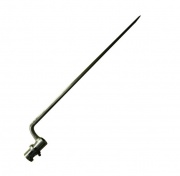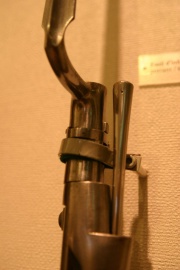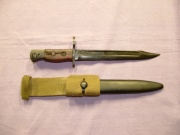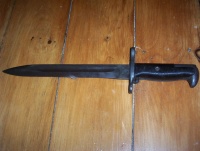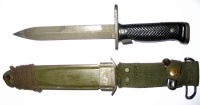Bayonet
A bayonet (from French baïonnette) is a knife-, dagger-, or spike-shaped weapon designed to fit on or over the muzzle of a rifle barrel or similar weapon, effectively turning the gun into a spear. It is a close-combat or last-resort weapon.
Contents |
[edit] History
The evolution of the bayonet can be traced to a certain extent to an accident. In the mid-17th century irregular military conflicts of rural France, the peasants of the Southern French town of Bayonne, who were Basques, having run out of powder and shot, rammed their long-bladed hunting knives into the muzzles of their primitive muskets to fashion impromptu spears and, by necessity, created an ancillary weapon that was to influence Western European infantry tactics well into the early 20th century. The weapon was introduced into the French army by General Jean Martinet.
There is evidence though that the first bayonet appeared in 13th century China. When the developer of the musket found they could not damage an enemy at close proximity, they introduced two types of firearm, one with an attached knife and the other a spear. One is called (梨花枪), and the other is (飞火枪)
The benefit of such a dual-purpose arm contained in one was soon apparent. The early muskets fired at a slow rate (about a round per minute when loading with loose powder and ball, and no more than 3–4 rounds per minute using paper cartridges), and were both inaccurate and unreliable. Bayonets provided a useful addition to the weapons system when an enemy charging to contact could cross the musket's killing ground (a range of approximately 100 yards/metres at the most optimistic) at the expense of perhaps only one or two volleys from their waiting opponents. A foot-long bayonet, extending to a regulation 17 inches (approx. 43 centimetres) during the Napoleonic period, on a 5-foot (around 1.5 metre) tall musket achieved a reach similar to the infantry spear, and later halberd, of earlier times.
Early bayonets were of the "plug" type. The bayonet had a round handle that slid directly into the musket barrel. This naturally prevented the gun from being fired. In 1671, plug bayonets were issued to the French regiment of fusiliers then raised. They were issued to part of an English dragoon regiment raised in 1672 and disbanded in 1674, and to the Royal Fusiliers when raised in 1685. The danger incurred by the use of this bayonet (which put a stop to all fire) was felt so early that the younger Puysgur saw a ring-bayonet in 1678 which could be fixed without stopping the fire. The defeat of forces loyal to William of Orange by Jacobite Highlanders at the Battle of Killiecrankie in 1689 was due (among other things) to the use of the plug-bayonet; and shortly afterwards the defeated leader, Hugh Mackay, is believed to have introduced a ring-bayonet of his own invention. Soon "socket" bayonets offset the blade from the musket barrel's muzzle. The bayonet attached over the outside of the barrel with a ring-shaped socket, secured on later models by a spring-loaded catch on the muzzle of the musket barrel.
A trial with badly fitting socket or zigzag bayonets was made after the battle of Fleurus, 1690, in the presence of Louis XIV, who refused to adopt them. Shortly after the Peace of Ryswick (1697), the English and Germans abolished the pike and introduced these bayonets, and plates of them are given in Surirey de St. Remy's Mémoires d'Artillerie, published in Paris in that year; but owing to a military cabal they were not issued to the French infantry until 1703. Henceforward, the bayonet became, with the musket or other firearm, the typical weapon of infantry.
Many socket bayonets were triangular in cross-section in order to provide flexing strength in the blade without much increase in weight. Flexing strength was needed in case a bayonet struck a hard object: better to have it bend and be repairable, than have it be stiff and shatter on impact. This design of bayonet did not usually include a grip for using the bayonet apart from the gun, although a socket bayonet was deemed a sidearm anyway, especially in the British army of 1775.
The triangular bayonet, unlike an old urban legend, was not designed to create stab wounds "that were difficult to stitch when attended to by a medic, as it is more difficult to stitch a three-sided wound than a two-sided one, thus making the wound more likely to become infected" (sic). This quote ignores the reality of surgery, in that surgeons have sewn up jagged wounds using more stitches when needed, since time immemorial. Instead, three sided bayonets were designed to be an economical compromise between flexing strength and the amount of wrought iron need to make the bayonet (compare to a structural steel Tee-beam).
Similarly, in the Soviet Union, later bayonet blades, now made of steel, were stiffened with a small cross-section in the form of a cross, in order to make them more compact in form and fold better onto the sides of their rifles (see Mosin Nagant model of 1944). It is said that self-inflicted wounds made by soldiers to get themselves out of the line of battle would be recognized as such and bring them greater disciplinary punishment. In All Quiet on the Western Front, Erich Maria Remarque, the book's author, reported that in World War I French soldiers killed German prisoners who had serrated blade bayonets, as they assumed they were for cutting off the limbs of Allied soldiers. These were carried by combat engineers as tools and by NCOs as signs of rank.
18th and 19th century military tactics included various massed bayonet charges and defenses. The Russian Army used the bayonet the most frequently in any Napoleonic conflict. Their motto was "The Bullet is foolish, the Bayonet wise". This implies that the bullet of a smoothbore musket was wildly inaccurate at ranges past 50 yards (which was true in most cases), but with the close quarters of bayonet fighting, it was hard to miss. It should be noted, however, that in the thick of a close-quarter combat, many soldiers revert to using bayonet-mounted rifles as clubs, this apparently being a more "natural" way of fighting (as described by military historians like John Keegan).
Bayonets were experimented with through much of the 18th and 19th centuries. In the United States Navy before the American Civil War, bayonet blades were even affixed to single-shot pistols, although they soon proved useless for anything but cooking. Cutlasses remained the favoured weapon for the navies of the time, though Queen Victoria's Royal Navy gave up the pikes once used to repel attacks by boarders in favor of the cutlass bayonet.
The 19th century finally saw the popularity of the sword bayonet. It was a long-bladed weapon with a single- or double-edged blade that could also be used as a shortsword. Its initial purpose was to ensure that riflemen, when in ranks with musketmen, whose weapons were longer, could form square properly to fend off cavalry attacks, when sword bayonets were fitted. A prime early example of a sword bayonet-fitted rifle would be the British Infantry Rifle of 1800-1840, later known as the "Baker Rifle". (However, one usually removed the sword bayonet on the Infantry Rifle before firing; the weight at the end of the barrel affected balance and stability, hence accuracy)
The hilt usually had quillons modified to accommodate the gun barrel, and a hilt mechanism that enabled the bayonet to be attached to a bayonet lug. When dismounted, a sword bayonet could be used in combat as a side arm. When attached to the musket or rifle, it effectively turned almost any long gun into a spear or glaive, suitable not only for thrusting but also for slashing. World War I saw the shortening of sword bayonets into knife-sized weapons, usable as fighting knives or trench knives, so that the vast majority of modern bayonets are knife bayonets.
[edit] Design
Modern bayonets are often knife-shaped with either a handle and a socket, or are permanently attached to the rifle as with the SKS. Depending on where and when a specific SKS was manufactured, it may have a permanently attached bayonet with a knife-shaped blade (Russian, Romanian, Yugoslavian, early Chinese), or a cruciform (late Chinese) or triangular (Albanian) spike bayonet, or no bayonet at all.
Most modern bayonets have a fuller (visible on the top half of the blade shown above), which is a concave depression in the blade designed to reduce the weight while keeping the blade's stiffness. Some speculate that this design feature makes a bayonet easier to withdraw after a stabbing attack by allowing air into the wound it produces, or to allow blood to drain from it, but in fact fullers have not been experimentally shown to have such an effect. Rather, the fuller increases the bending strength of the blade in the same way the "I" cross-section of an I-Beam is more efficient in resisting bending than an equivant rectangular cross-section. [1]
[edit] Modern use

The advent of modern warfare in the 1800s decreased the bayonet's usefulness, and as early as the U.S. Civil War (1861–65) the bayonet was ultimately responsible for less than one percent of battlefield casualties.[1] Modern warfare still sees the use of the bayonet for close-quarter fighting. British forces, for example, performed bayonet charges during the Falklands War and the Second Gulf War.[2] During the Korean War, Lewis L. Millett led soldiers of the US 27th Infantry Regiment in taking out a Chinese machine gun position with bayonets. Millett was awarded the Medal of Honor for this action.
In the US Marine Corps, trainees at the Marine Corps Recruit Depot in San Diego for instance get their first instruction in using the bayonet as a lethal weapon on their 10th day. The essence of bayonet fighting as taught in the Corps is to spring forward from a modified crouch and thrust the blade into the enemy. Recruits are taught to slash an enemy diagonally from shoulder to hipbone and how to use a bayonet to push aside an enemy's weapon.
In a modern context, bayonets are used for controlling prisoners and as a "last resort" weapon for close quarters combat, in cases where a soldier is out of ammo or if a weapon has jammed. However, they are not normally fitted to weapons except when such situations are at hand, because the bayonet impairs long-range accuracy, as its weight alters the rifle's balance.
A bayonet also remains useful as a utility knife, and as an aid to combat morale. Training in the use of the bayonet has been given precedence long after the combat role of the bayonet declined as it is thought to increase desired aggressiveness in troops. Despite the limitations of the bayonet, many modern assault rifles retain a bayonet lug and the weapon is still issued in many armies. Examples are the M16, AK-47, and the Sig 550.
Bayonets were used as a direct attack weapon by Argyll and Sutherland Highlanders troops from the British Army in the second conflict in Iraq. When two landrovers of Highlander troops were ambushed by soldiers loyal to cleric Moqtada al-Sadr, the Highlander troops fixed bayonets to their rifles and charged the militiamen. 30 Iraqi gunman were killed and 12 were captured.[2]
[edit] Commonwealth armies
In armies of the Commonwealth of Nations, in close-order drill the command to fix bayonets is a two-part command. It consists of the preparatory order "Fix" and the execution order "BAYONETS". It is issued only from the Order Arms position. The commands to "Fix" and "Unfix" bayonets are among the only drill commands not executed in a specified cadence.
In the Rifle Regiments of the British Army, using a practice harkening back to the days when their flintlock rifles carried sword bayonets, the command is "Fix....SWORDS!". Bayonets are also fixed on the command, "Prepare to Assault", which is given towards the end of a section or fire team attack. The bayonet in the Canadian Forces is fitted on the front of the Tactical Vest for easy access.
[edit] U.S

The modern sawback US M9 bayonet, officially adopted in 1984, is issued with a special sheath designed to double as a wire cutter, developed by Phrobis III. Some production runs of the M9 have a fuller and some do not, depending upon which contractor manufactured that batch and what the military specs were at the time. The M9 bayonet partially replaced, but is used in addition to, the older M6 and M7 bayonets, introduced in 1957 and 1964 respectively. Many troops have retained the M7, since the M9 has a reputation for breakage due to a combination of its thin blade and varying quality among the various contractors used.
As of 2002, the US Marine Corps is also issuing small quantities of new bayonets of a different design from the M9, with an 8-inch Bowie knife-style blade and no fuller, manufactured by the Ontario Knife Company of New York. This new bayonet, the OKC-3S, is cosmetically similar to the Marines' famed Ka-bar fighting knife. The weapon upgrade is part of a push begun four years ago by then-Commandant Gen. James L. Jones to expand and toughen hand-to-hand combat training for Marines, including more training in the martial arts and knife fighting. The new bayonet — with a steel blade is 8" long, 1-3/8" wide, .2" thick blade, and weighing 1¼ pounds with its sheath — is slightly longer, thicker, and heavier than the current M9. A sharper point and serrations near the handle help penetrate body armor that many modern adversaries wear. In one demonstration, a prototype was able to pierce a punching bag covered with aircraft aluminum and a bulletproof flak jacket. Also, the handle is more oval than round to prevent repetitive-stress injuries during training.
"We spent a lot of time making sure the handle was ergonomically correct… There are no blister points on the handle. The Marines are the best and they deserve the best."[3]
In United States Marine Corps drill and ceremonies, the command "FIX... BAYONETS!" is executed in four movements from the order arms position. In the United States Army, the movement is also executed from order arms; there are no specified movements, but the bayonet is to be attached quickly and quietly.
[edit] Cultural impact
The push-twist motion of fastening the older type of bayonet has given name to:
- The "bayonet mount" used for various types of quick fastenings, such as camera lenses.
- Several connectors and contacts including the bayonet-fitting light bulb that is common in the UK (as opposed to the continental screw-fitting type).
- The BNC ("Bayonet Neill-Concelman") RF connector.
The bayonet has become a symbol of military power. The term "at the point of a bayonet" refers to using military force or action to accomplish, maintain, or defend something.
The Australian Army 'Rising Sun' badge features a semi-circle of bayonets.
The U.S. Army Combat Action Badge, awarded to personnel who have come under fire since 2001 and who are not eligible for the Combat Infantryman Badge, has a bayonet as its central motif.
Undertaking a task 'with fixed bayonets' has this connotation of no room for compromise and is a phrase used particularly in politics.
The shoulder sleeve insignia for the 10th Mountain Division in the U.S. Army features crossed bayonets.
[edit] References
[edit] Footnotes
- ↑ O'Connell, Robert L., "Arme Blanche", Military History Quarterly, Vol. 5, nº 1.
- ↑ 2.0 2.1 The Telegraph, 2004-06-13.
- ↑ Nick Trbovich Jr., president and chief executive of Ontario Knife Co., which won the Marine bayonet contract after a yearlong competition. It can also double as a fighting knife.
[edit] See also
- Gunpowder warfare
- Knife bayonet
- Pistol sword
- Bayonet lug
- Spike bayonet
- Sword bayonet
- List of bayonets by country
